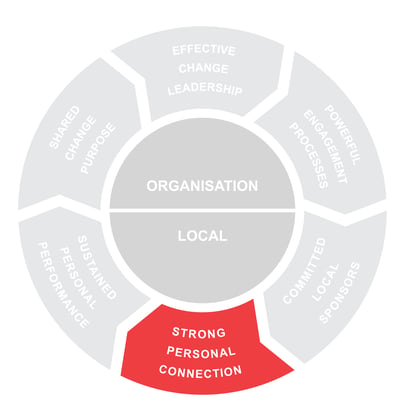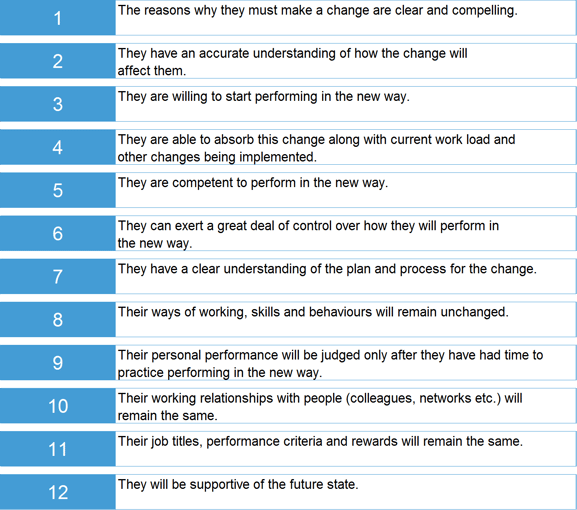
Individuals that have a personal connection to a change are more likely to accept, and even move to being strongly committed to, the change. Change requires people to change their actions and behaviour. An individual’s willingness to embrace and support the change is key for a successful change project. Creating that strong personal connection to change is the second local critical success factor.
During July and August we are discussing the 6 critical success factors for change. Three success factors sit at the organizational level; three factors sit at the local level. This week we will look at CSF5, and provide insights on how to help impacted individuals in your organization develop a strong personal connection to your change project.

Critical Success Factor 5: Strong Personal Connection
There are three components of a strong personal connection:
- Personal imperative – people realizing that they personally need to change.
- Solution viability – people believing the changes they have to make are achievable.
- Being successful – people understanding how they can be successful.
Keep these three aspects in mind as you develop and enact your plan to help people develop a strong personal connection to the change.
Creating and nurturing connection to change
Get your middle and front-line managers ready to support the change implementation. If you have built a network of strong local sponsors, then you are one step towards building personal commitment to your change project. A personal connection is, by its very nature, an individual reaction; local and front-line managers are the ones who need to be working directly with their teams to help individuals build this personal connection.
Be prepared to support your local sponsors. Remember to train, coach and reward them for working with their teams to develop personal connections.
People develop a personal connection to a change through involvement. They need face-to-face contact and the opportunity to debate, discuss and argue to build personal levels of readiness to change.
Encourage your local sponsors to work closely with their teams, to encourage discussion and debate about the planned change. Work with your local sponsors to adapt the organizational change vision and strategy into terms that will resonate with local teams. A high level strategic statement about the need for change will not necessarily resonate at the individual level.
Understand the risk areas using a tool such as the Adapter Readiness Assessment. While we don’t expect, or need, every individual to be ambassadors for the change, helping individuals understand and be prepared to adapt to the change will significantly increase success of your change project.
The Adapter Readiness Assessment will give you and your local sponsors a good understanding of where the impacted individuals – those who need to adapt to the change – currently sit in respect to being ready to change. Identifying the highest risk areas within your teams will provide your local sponsors key insights into areas they need to focus on and address.

Of the 12 readiness dimensions, we have found that the 5 highlighted dimensions are the key risk areas for almost every change, and suggest ensuring these areas of concern are addressed early, and often.
Paint a tangible picture of the future state, and how the team will get there. When discussing and debating the change it is important to be as tangible and concrete in the information provided as possible. Some approaches for doing this include:
- describe change in as much detail as possible
- highlight the local area’s contribution or connection to the vision, imperative and solution
- identify early actions that can be accomplished to move the change forward
- work with employees to develop ‘A day in the life of’ stories to create a picture of what success looks like in the future
- find ways for people to test the new way of working without any negative consequences if they make mistakes
- use actions more than words, to demonstrate what the change means.
Increase the success of your change management projects by taking action to help people develop a personal commitment to change. This is a complex area, and one which is often overlooked in change management plans, but one which is critical for successful change management.
Learn more about how to develop personal connections to change in chapter 9 of our book, Successful Change. If you would like to learn more about the Adapter Readiness Assessment contact us to learn how this assessment can help your change projects.


Leave a comment